Alexander Martin
WikiVideo: Article Generation from Multiple Videos
Apr 01, 2025Abstract:We present the challenging task of automatically creating a high-level Wikipedia-style article that aggregates information from multiple diverse videos about real-world events, such as natural disasters or political elections. Videos are intuitive sources for retrieval-augmented generation (RAG), but most contemporary RAG workflows focus heavily on text and existing methods for video-based summarization focus on low-level scene understanding rather than high-level event semantics. To close this gap, we introduce WikiVideo, a benchmark consisting of expert-written articles and densely annotated videos that provide evidence for articles' claims, facilitating the integration of video into RAG pipelines and enabling the creation of in-depth content that is grounded in multimodal sources. We further propose Collaborative Article Generation (CAG), a novel interactive method for article creation from multiple videos. CAG leverages an iterative interaction between an r1-style reasoning model and a VideoLLM to draw higher level inferences about the target event than is possible with VideoLLMs alone, which fixate on low-level visual features. We benchmark state-of-the-art VideoLLMs and CAG in both oracle retrieval and RAG settings and find that CAG consistently outperforms alternative methods, while suggesting intriguing avenues for future work.
MMMORRF: Multimodal Multilingual Modularized Reciprocal Rank Fusion
Mar 26, 2025
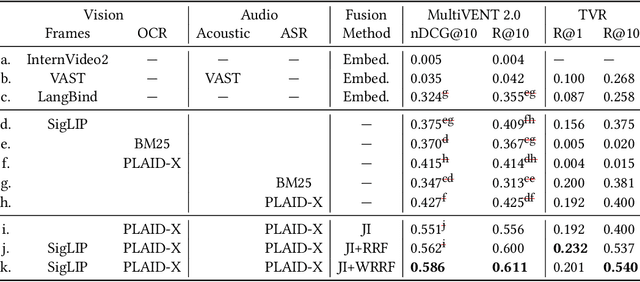

Abstract:Videos inherently contain multiple modalities, including visual events, text overlays, sounds, and speech, all of which are important for retrieval. However, state-of-the-art multimodal language models like VAST and LanguageBind are built on vision-language models (VLMs), and thus overly prioritize visual signals. Retrieval benchmarks further reinforce this bias by focusing on visual queries and neglecting other modalities. We create a search system MMMORRF that extracts text and features from both visual and audio modalities and integrates them with a novel modality-aware weighted reciprocal rank fusion. MMMORRF is both effective and efficient, demonstrating practicality in searching videos based on users' information needs instead of visual descriptive queries. We evaluate MMMORRF on MultiVENT 2.0 and TVR, two multimodal benchmarks designed for more targeted information needs, and find that it improves nDCG@20 by 81% over leading multimodal encoders and 37% over single-modality retrieval, demonstrating the value of integrating diverse modalities.
Video-ColBERT: Contextualized Late Interaction for Text-to-Video Retrieval
Mar 24, 2025Abstract:In this work, we tackle the problem of text-to-video retrieval (T2VR). Inspired by the success of late interaction techniques in text-document, text-image, and text-video retrieval, our approach, Video-ColBERT, introduces a simple and efficient mechanism for fine-grained similarity assessment between queries and videos. Video-ColBERT is built upon 3 main components: a fine-grained spatial and temporal token-wise interaction, query and visual expansions, and a dual sigmoid loss during training. We find that this interaction and training paradigm leads to strong individual, yet compatible, representations for encoding video content. These representations lead to increases in performance on common text-to-video retrieval benchmarks compared to other bi-encoder methods.
Cross-Document Event-Keyed Summarization
Oct 18, 2024



Abstract:Event-keyed summarization (EKS) requires generating a summary about a specific event described in a document, given the document and an event representation extracted from it. In this work, we extend EKS to the cross-document setting (CDEKS), in which summaries must synthesize information from accounts of the same event given by multiple sources. We introduce SEAMUS (Summaries of Events Across Multiple Sources), a high-quality dataset for CDEKS based on an expert reannotation of the FAMUS dataset for cross-document argument extraction. We present a suite of baselines on SEAMUS, covering both smaller, fine-tuned models, as well as zero- and few-shot prompted LLMs, along with detailed ablations, and a human evaluation study, showing SEAMUS to be a valuable benchmark for this new task.
MultiVENT 2.0: A Massive Multilingual Benchmark for Event-Centric Video Retrieval
Oct 15, 2024Abstract:Efficiently retrieving and synthesizing information from large-scale multimodal collections has become a critical challenge. However, existing video retrieval datasets suffer from scope limitations, primarily focusing on matching descriptive but vague queries with small collections of professionally edited, English-centric videos. To address this gap, we introduce $\textbf{MultiVENT 2.0}$, a large-scale, multilingual event-centric video retrieval benchmark featuring a collection of more than 218,000 news videos and 3,906 queries targeting specific world events. These queries specifically target information found in the visual content, audio, embedded text, and text metadata of the videos, requiring systems leverage all these sources to succeed at the task. Preliminary results show that state-of-the-art vision-language models struggle significantly with this task, and while alternative approaches show promise, they are still insufficient to adequately address this problem. These findings underscore the need for more robust multimodal retrieval systems, as effective video retrieval is a crucial step towards multimodal content understanding and generation tasks.
Grounding Partially-Defined Events in Multimodal Data
Oct 07, 2024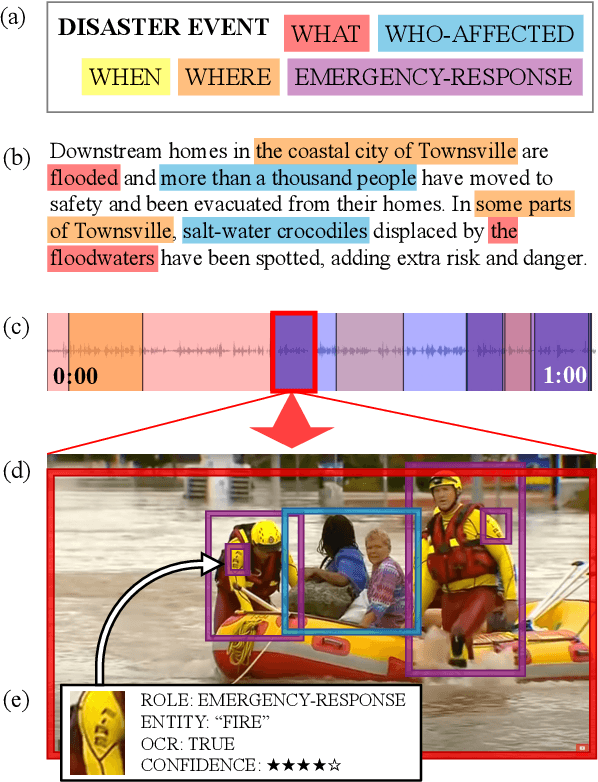
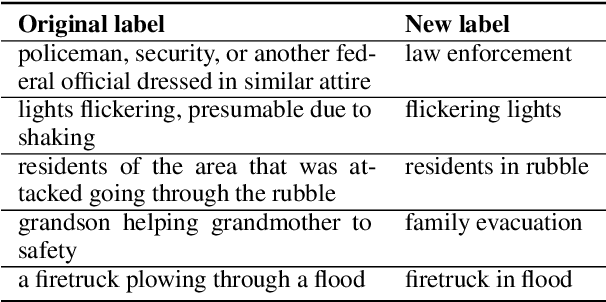

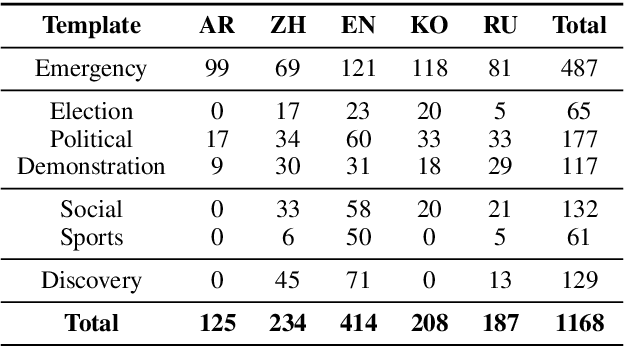
Abstract:How are we able to learn about complex current events just from short snippets of video? While natural language enables straightforward ways to represent under-specified, partially observable events, visual data does not facilitate analogous methods and, consequently, introduces unique challenges in event understanding. With the growing prevalence of vision-capable AI agents, these systems must be able to model events from collections of unstructured video data. To tackle robust event modeling in multimodal settings, we introduce a multimodal formulation for partially-defined events and cast the extraction of these events as a three-stage span retrieval task. We propose a corresponding benchmark for this task, MultiVENT-G, that consists of 14.5 hours of densely annotated current event videos and 1,168 text documents, containing 22.8K labeled event-centric entities. We propose a collection of LLM-driven approaches to the task of multimodal event analysis, and evaluate them on MultiVENT-G. Results illustrate the challenges that abstract event understanding poses and demonstrates promise in event-centric video-language systems.
Hi5: 2D Hand Pose Estimation with Zero Human Annotation
Jun 05, 2024



Abstract:We propose a new large synthetic hand pose estimation dataset, Hi5, and a novel inexpensive method for collecting high-quality synthetic data that requires no human annotation or validation. Leveraging recent advancements in computer graphics, high-fidelity 3D hand models with diverse genders and skin colors, and dynamic environments and camera movements, our data synthesis pipeline allows precise control over data diversity and representation, ensuring robust and fair model training. We generate a dataset with 583,000 images with accurate pose annotation using a single consumer PC that closely represents real-world variability. Pose estimation models trained with Hi5 perform competitively on real-hand benchmarks while surpassing models trained with real data when tested on occlusions and perturbations. Our experiments show promising results for synthetic data as a viable solution for data representation problems in real datasets. Overall, this paper provides a promising new approach to synthetic data creation and annotation that can reduce costs and increase the diversity and quality of data for hand pose estimation.
Event-Keyed Summarization
Feb 10, 2024



Abstract:We introduce event-keyed summarization (EKS), a novel task that marries traditional summarization and document-level event extraction, with the goal of generating a contextualized summary for a specific event, given a document and an extracted event structure. We introduce a dataset for this task, MUCSUM, consisting of summaries of all events in the classic MUC-4 dataset, along with a set of baselines that comprises both pretrained LM standards in the summarization literature, as well as larger frontier models. We show that ablations that reduce EKS to traditional summarization or structure-to-text yield inferior summaries of target events and that MUCSUM is a robust benchmark for this task. Lastly, we conduct a human evaluation of both reference and model summaries, and provide some detailed analysis of the results.
FAMuS: Frames Across Multiple Sources
Nov 09, 2023Abstract:Understanding event descriptions is a central aspect of language processing, but current approaches focus overwhelmingly on single sentences or documents. Aggregating information about an event \emph{across documents} can offer a much richer understanding. To this end, we present FAMuS, a new corpus of Wikipedia passages that \emph{report} on some event, paired with underlying, genre-diverse (non-Wikipedia) \emph{source} articles for the same event. Events and (cross-sentence) arguments in both report and source are annotated against FrameNet, providing broad coverage of different event types. We present results on two key event understanding tasks enabled by FAMuS: \emph{source validation} -- determining whether a document is a valid source for a target report event -- and \emph{cross-document argument extraction} -- full-document argument extraction for a target event from both its report and the correct source article. We release both FAMuS and our models to support further research.
Jurassic World Remake: Bringing Ancient Fossils Back to Life via Zero-Shot Long Image-to-Image Translation
Aug 14, 2023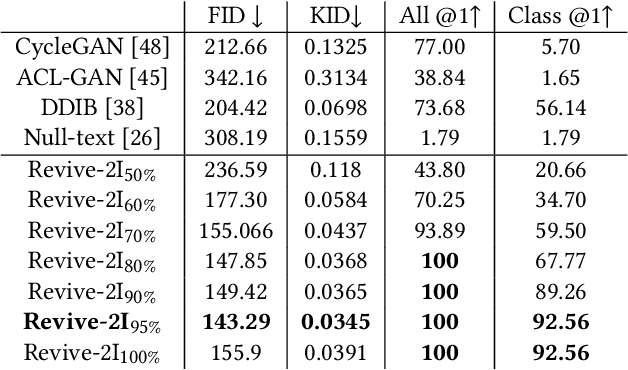
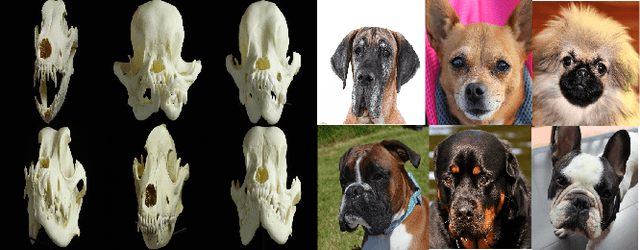

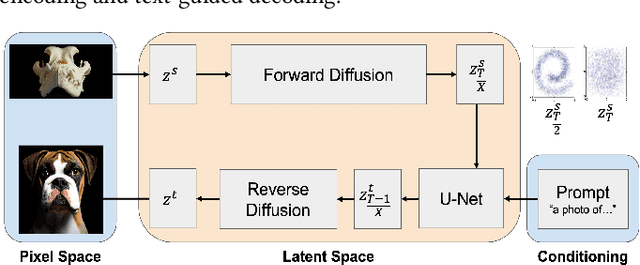
Abstract:With a strong understanding of the target domain from natural language, we produce promising results in translating across large domain gaps and bringing skeletons back to life. In this work, we use text-guided latent diffusion models for zero-shot image-to-image translation (I2I) across large domain gaps (longI2I), where large amounts of new visual features and new geometry need to be generated to enter the target domain. Being able to perform translations across large domain gaps has a wide variety of real-world applications in criminology, astrology, environmental conservation, and paleontology. In this work, we introduce a new task Skull2Animal for translating between skulls and living animals. On this task, we find that unguided Generative Adversarial Networks (GANs) are not capable of translating across large domain gaps. Instead of these traditional I2I methods, we explore the use of guided diffusion and image editing models and provide a new benchmark model, Revive-2I, capable of performing zero-shot I2I via text-prompting latent diffusion models. We find that guidance is necessary for longI2I because, to bridge the large domain gap, prior knowledge about the target domain is needed. In addition, we find that prompting provides the best and most scalable information about the target domain as classifier-guided diffusion models require retraining for specific use cases and lack stronger constraints on the target domain because of the wide variety of images they are trained on.
 Add to Chrome
Add to Chrome Add to Firefox
Add to Firefox Add to Edge
Add to Edge